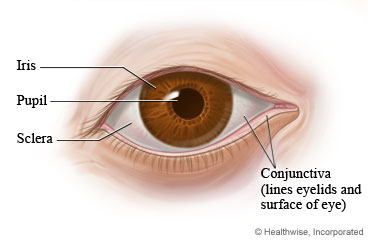
Your Care Instructions
Cellulitis of the eye is an infection of the skin and tissues around the eye. It is also called preseptal cellulitis or periorbital cellulitis. This type of infection is often caused by bacteria. It may happen after a sinus infection, a dental infection, an insect bite, or an injury to the face.
This eye problem can be very serious, depending on what part of the eye it affects. But it often goes away without lasting problems if it is treated right away. Medicine and home treatment will help your child get better.
Follow-up care is a key part of your child's treatment and safety. Be sure to make and go to all appointments, and call your doctor if your child is having problems. It's also a good idea to know your child's test results and keep a list of the medicines your child takes.
How can you care for your child at home?
- Give your child antibiotics as directed. Do not stop using them just because your child is feeling better. Your child needs to take the full course of antibiotics.
- Your child should not wear contact lenses unless the doctor says it is okay.
- Prop up your child's head on pillows. Put a cool, damp cloth on the eye. This helps reduce swelling and relieve pain. The doctor may suggest using a warm pack to help heal the infection.
- Keep the skin around your child's eye clean and dry.
- Be safe with medicines. Read and follow all instructions on the label.
- If the doctor gave your child a prescription medicine for pain, give it as prescribed.
- If your child is not taking a prescription pain medicine, ask your doctor if your child can take an over-the-counter medicine.
To prevent cellulitis
- Make sure that your child washes their hands well after using the bathroom and before and after eating.
- Do not let your child rub or pick at the skin around the eyes. Cellulitis occurs most often where there is a break in the skin.
- Call the doctor if your child has a sinus infection with redness or swelling of the eyes.
- If your child gets a cut, pimple, or insect bite near the eye, clean the wound as soon as you can. This can help prevent an infection.
- Wash the area with cool water and a mild soap, such as Ivory.
- Do not use rubbing alcohol, hydrogen peroxide, iodine, or Mercurochrome. These can harm the tissues and slow healing.
When should you call for help?
Call your doctor now or seek immediate medical care if:
- Your child has signs of an eye infection, such as:
- Pus or thick discharge coming from the eye.
- Redness or swelling around the eye.
- A fever.
- Your child's eye seems to be bulging out.
- Your child seems to be getting sicker.
- Your child has vision changes.
Watch closely for changes in your child's health, and be sure to contact your doctor if:
- Your child does not get better as expected.
Where can you learn more?
Go to http://www.healthwise.net/patientEd
Enter P514 in the search box to learn more about "Cellulitis of the Eye in Children: Care Instructions".
Current as of: July 31, 2024
Author: Ignite Healthwise, LLC Staff
Clinical Review Board
All Ignite Healthwise, LLC education is reviewed by a team that includes physicians, nurses, advanced practitioners, registered dieticians, and other healthcare professionals.

